Saturday’s field trip saw us travel to southeast Ohio to visit Deep Woods Farm Preserve. Following our theme of geobotany from the previous field trip to Battelle-Darby Metropark, Deep Woods is an example of unglaciated Ohio’s acidic sandstone substrate. This substrate allows for a much different plant community than the limestone substrate of Battelle. Additionally, Deep Woods (and the rest of southeast Ohio) is located in the western foothills of Appalachia, well known for its biodiversity. Here are just a few of the interesting endemic plants I saw during our walk through Deep Woods!
While walking on a woody ridge we stumbled across this chestnut oak (Quercus montana) seedling. Chestnut oaks grow in dry upland areas and are associated with the acid sandstone typical of the area. The common name of this tree comes the resemblance of its leaves, to the leaves of the unfortunately endangered American chestnut. It can potentially be confused by its limestone-loving northern cousin, the chinquapin oak (Quercus muehlenbergii). A good way to tell the difference is to look at the leaf margins: chestnut oaks have wavier edges, whereas chinquapin oaks are sharply toothed.
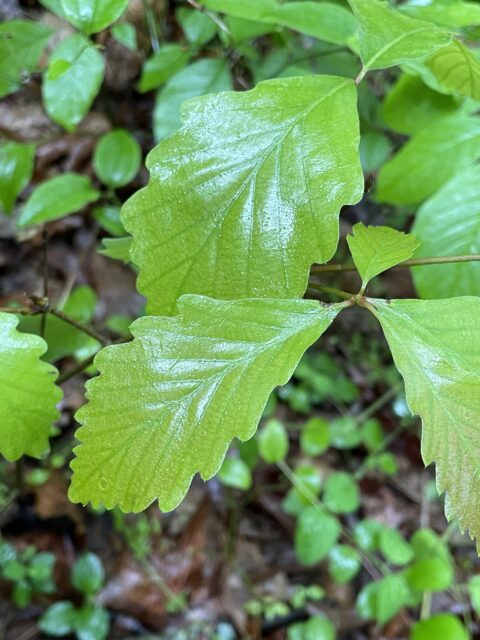
Leaf detail of chestnut oak. Note the rounded teeth.
This toothy tree was encountered at the bottom of a cool, wet ravine, much different than where we found the chestnut oak. This is an eastern hemlock (Tsuga canadensis). These conifers have tiny, pendant-shaped cones that I personally find quite cute, although I didn’t see any on this individual. Apparently, a tea was once made out of the leaves and twigs by woodsmen and local Indigenous tribes.
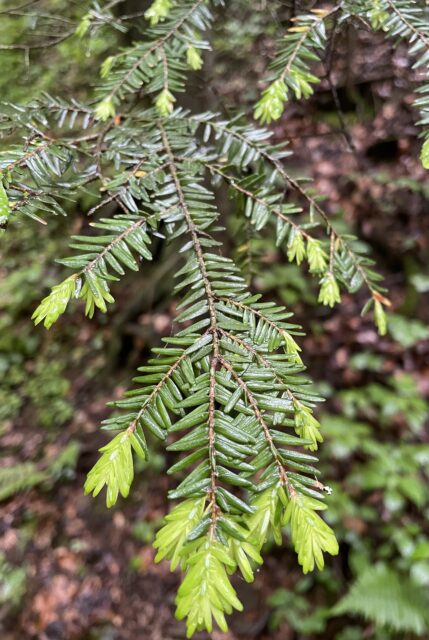
Leaf detail of eastern hemlock.
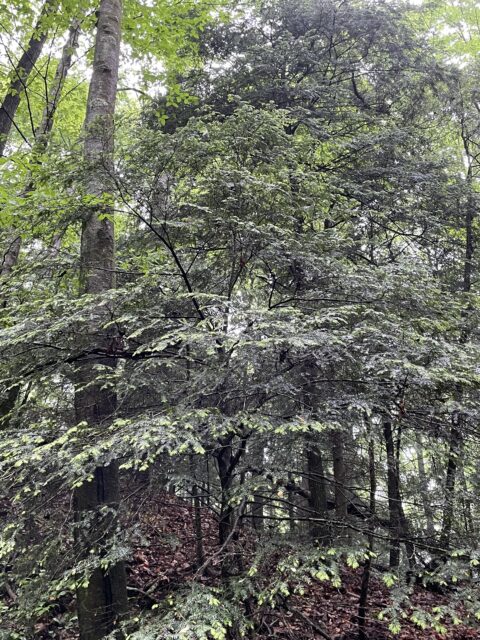
Eastern hemlock full tree.
Not too far from the hemlock was a wildflower known as Solomon’s seal (Polygonatum biflorum). This plant is actually a member of the lily family, making it a monocot. The unusual name comes from a scar on the rhizome said to resemble the royal seal of the the biblical King Solomon. It has seen a wide range of use in herbal medicine, being used to treat ailments ranging from gout to rheumatism. If you look closely at the picture, you’ll notice the bell-like flowers drooping off the underside of the arching stem.
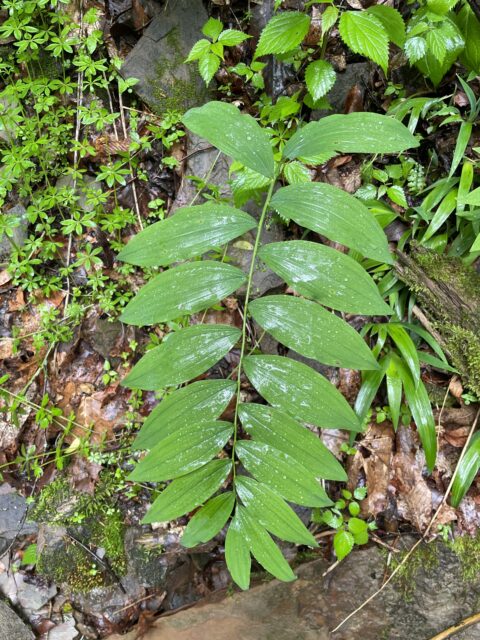
Solomon’s seal.
At the wooded edge of a grassy meadow was this sourwood (Oxydendrum arboreum) seedling. These trees are members of the heath family, and are the only members of the family that reach full tree size. It’s actually not the wood that’s sour, but rather the leaves (I didn’t try any though, I ate some wood-sorrel earlier). This tree is renowned for the honey produced from its nectar, which I would love to try someday.
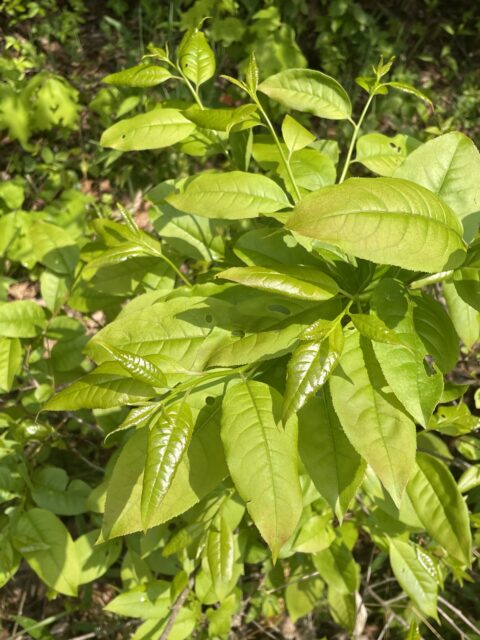
Sourwood seedling.
This was also our first field trip where we observed ferns in great detail. We were all tasked to document and identify four species of fern, which was honestly a little overwhelming! I’d never identified ferns before and it seemed like everywhere I looked the forest floor was carpeted in these prehistoric plants. I did manage to find some (with the help of Dr. Klips’ ID tips). I’ve decided to to pay more attention to ferns from now on, because they’re really fascinating and (in my opinion), just as beautiful as any flowering plant.
The following ferns were identified by their frond type, their frond dissection type, and their indusium type.
Frond types:
- Monomorphic = spores are produced under otherwise normal looking fronds
- Hemidimorphic = fronds are divided into “fertile” and “sterile” portions
- Holodimorphic = fronds are divided into strikingly different types, devoted entirely to either spore production or photosynthesis
Frond dissection types:
- Entire = wholly undivided
- Pinnatifid = lobed, but not entirely divided into separate pinnae or pinnules
- Pinnate = wholly divided into separate leaflets
- Pinnate-pinnatifid = wholly divided into leaflets, which are lobed!
- Bipinnate = wholly divided into leaflets, which are wholly divided
….continues into Bipinnate-pinnatifid, Tripinnate, and so on!
Indusium type:
- Naked = no indusium
- False = margin of the leaf curls over the sori
- Peltate = circular, attached to the leaf by a central stalk
- Reniform = kidney shaped
- Linear = long and narrow
The first fern we encountered, and a very common one in the area, was Christmas fern (Polystichum acrostichodes). Christmas fern is hemidimorphic, pinnate, and has a peltate indusium.

Christmas fern. Note how small the leaves at the top of the frond are compared to the ones at the base. The top ones are devoted to spore production.
In the same ravine where we found the hemlock and the Solomon’s seal were silvery spleenwort (Deparia acrostichodes) and spinulose wood fern (Dryopteris carthusiana). Silvery spleenwort is monomorphic, pinnate-pinnatifid, and has a linear indusium.
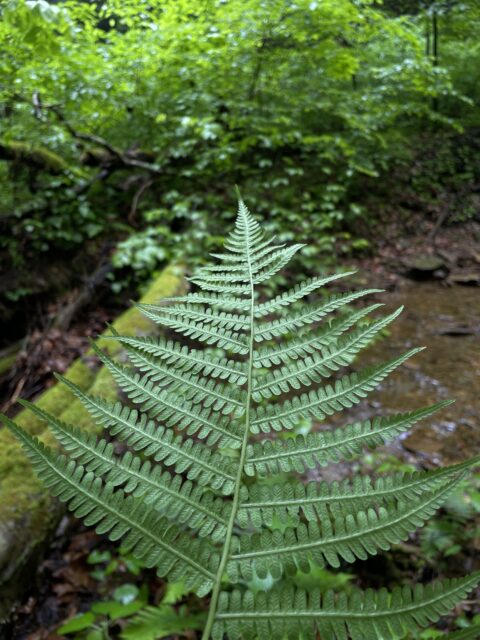
Silvery spleenwort frond.
Spinulose wood fern is monomorphic, bipinnate-pinnatifid, and has a reniform indusium.
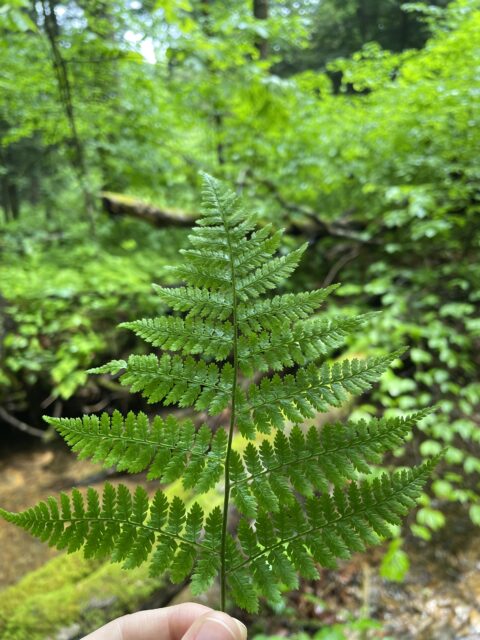
Spinulose wood fern frond.
Maidenhair fern (Adiantum pedatum) is an interesting species with a delicate appearance. It is monomorphic, tripinnate, and has a false indusium.

Maidenhair fern frond.
Maybe the most unique fern we saw at Deep Woods is one that doesn’t really resemble a fern at all, or at least not the popular image of one. Reader, I ask you to prepare yourself to witness true botanical glory…..
Behold the Appalachian gametophyte (Vittaria appalachiana)!!!!

Appalachian gametophyte specimen on the wall of a cave.
Not the most visually exciting, but that’s not why it’s interesting. As the name suggests, this fern only exists in the gametophyte stage, and reproduces asexually via gemmae, rather than sexually via spores. It only grows in moist rock outcrops and caves. Botanists have puzzled for decades over the origin of this fern. However, this 2016 article from the American Journal of Botany helps shed some light on the situation.
As mentioned above, the Appalachian gametophyte reproduces via gemmae-vegetative propagules made of a few cells, which are produced along the margin of the gametophyte. Gemmae are much larger than spores, and can only disperse short distances compared to them. Spores are usually dispersed long-distance via wind, whereas gemmae are likely dispersed short-distance via wind, water, and possibly animals (slugs have been observed transporting gemmae of different species). The limited dispersal ability of the Appalachian gametophyte’s gemmae is supported by its absence past the glacial boundary. Despite this, the species has a wide range across the Appalachian Mountains. Given this information, it is likely that this species once possessed a functional sporophyte stage that allowed for its current wide range. The sporophyte probably became extinct before or during the Pleistocene glaciation, which would explain why the species doesn’t occur past the glacial boundary. In the present, this little plant only exists as a tiny green mat of foliage, tucked away in rock crevices and caves. Despite having lost a whole stage of its life cycle, it continues to survive, and even thrive where most animals or even fellow plants would never go.
Despite its vast native biodiversity, even Deep Woods is not immune to invasive plants. Multiflora rose and Japanese stiltgrass formed dense thickets in the understory, putting up fierce competition with the local flora.
But let’s end this page on a high note. For my individual assignment, I was tasked with finding two members of the Saxifragaceae family. This is a family of flowering herbaceous perennials. Their flowers are borne on racemes or cymes, and are usually bisexual. The petals are clawed and occasionally, finely dissected. Flowers have five to ten stamens, and the ovary is inferior. They are primarily found in temperate and arctic regions of the Northern hemisphere.
The two species I came across were found in the wet ravine. The first one is known as miterwort, or bishop’s cap (Mitella diphylla). I really like the petals on this plant, they’re finely dissected and remind me of tiny snowflakes!
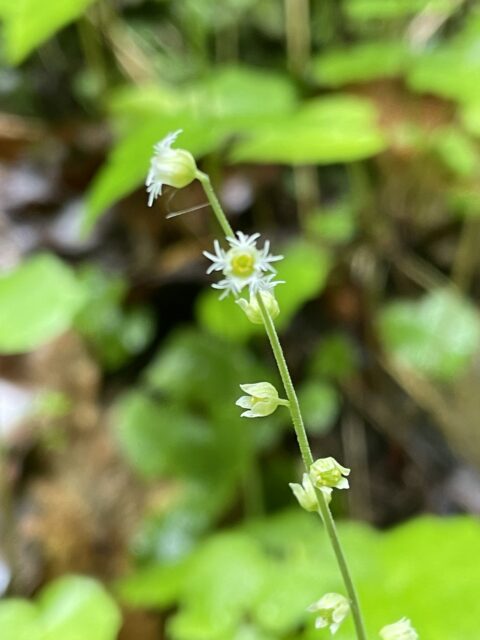
Miterwort inflorescences.
The second species is known as foamflower (Tiarella cordifolia). I think this one is also really pretty. It’s a little more showy than the miterwort, with stamens that extend far past the petals.

Foamflower inflorescences.
